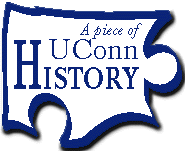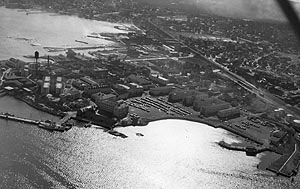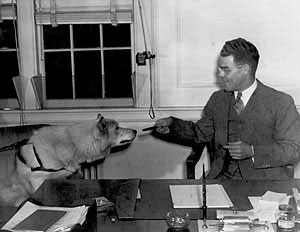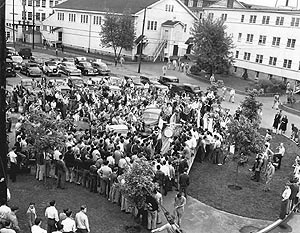|
This is an archived article.
For the latest news, go to the Advance
Homepage
For more archives, go to the Advance Archive/Search Page. |
|||||||
|
Short-Lived Fort Trumbull Campus Offered
World War II Veterans a UConn Education
From its opening on Sept. 16, 1946, to its closing in June 1950, Fort Trumbull held the distinction - one it still holds - of being the only residential branch campus of the University.
With the end of the second world war, tens of thousands of veterans returning home found higher education a better alternative than trying to land a scarce job. And with the G.I. Bill of Rights offering them a subsidized college education, the sheer number of veterans presented a problem for all the nation's colleges and universities. More than 8,000 students were enrolled in the University of Connecticut in the 1946-47 academic year, four times the number registered in the period shortly preceding the war. And of those 8,000 students, more than half were veterans. Anticipating the approaching enrollment crunch, UConn President Albert N. Jorgensen received trustee approval on May 17, 1945 to begin looking at the former U.S. Maritime Training School at Fort Trumbull in New London as a campus for returning soldiers and sailors. And at the July 17, 1946 meeting of the trustees, he reported that an agreement had been reached to open the facility as a UConn campus in the coming fall semester. Fort Trumbull wasn't the only measure for handling the influx of returning G.I.s: 11 temporary barracks were built in Storrs on the site of a former agronomy garden along Route 195 (now the site of the fine arts complex). Because of its location far from the center of the then smaller main campus, it was dubbed "Siberia." Also in the summer of 1946, the University took over part of a federal housing project in Willimantic - built for Pratt & Whitney Aircraft workers during the war - to house 100 married G.I.s and their families. The conversion of Fort Trumbull from a war training site to college campus was rapid - two months after receiving federal approval to use the facilities, students began moving in and taking classes. During the two months of preparation, about 70 staff were recruited, including the late Max B. Thatcher, who headed the political science department (then called the department of government), and English professor Marion Starkey, who would later teach at the Hartford campus. Courses, including art through zoology, were offered by the College of Agriculture, College of Arts & Sciences, School of Business and School of Engineering. As at other UConn regional campuses, students took freshmen and sophomore-level courses and moved to the Storrs campus for their junior and senior years. One of the problems facing University staff was the lack of beds or bedding in some of the eight three-story dormitories. Clarence A. Weber, a professor of education who was director of the Fort Trumbull campus during its entire existence, reported that just as students were moving in, mattresses and pillows were being sent out for sterilization, causing some confusion. A student would "make up his bed only to return to his room later to find his blankets neatly rolled up and his mattress gone," wrote Weber in a 1947 report. There also were no locks on many of the dormitory rooms - and for those rooms and buildings for which there were locks, Weber and his staff found "bushels and bushels of keys with no identifying tags." Finding the right keys for the right locks, changing locks and cutting new keys kept everyone busy. On Oct. 17, 1946, the first issue of a weekly campus newspaper, The Trumbull Tide, was published. The paper continued its run through May 1950, including an annual April Fool's issue, The Trum Bull. Other aspects of student life were similar to that of the main campus at Storrs: a bookstore, dining hall and coffee shop, dormitories, classrooms, laboratories and administrative offices. There was even a student radio station, WRUM, which first broadcast over the campus public address system with four hours of programming Monday through Thursday. Later, broadcasting at 640 on the AM dial, the station expanded to an all-day schedule of music, campus talent shows, and special events. There were also some facilities for students at Fort Trumbull not found in Storrs: a student union (Storrs did not have one until 1953); two bowling alleys; and a small fleet of boats, both for rowing and sailing. For the first year, six of the eight dormitories housed single men and two were for married students and their families. Dorm names took a nautical theme: Lightning, Comet, Tradewinds, Dreadnaught, Rainbow, Flying Cloud, Typhoon and Red Jacket. A major event in the short life of the campus was a dormitory fire on Jan. 24, 1948. The Norwich Bulletin reported that the fire started in the afternoon "a few minutes after the advent of a driving snowstorm, which along with temperatures reading 10 degrees above zero, hindered firemen." Four hundred students were evacuated from their rooms but, despite the fierce winter weather, only two dormitories were lost: Typhoon was destroyed and Red Jacket was declared uninhabitable due to water damage. The displaced students were housed in the gymnasium, infirmary, and in space available in other dormitories. The original agreement for the use of the Fort Trumbull facilities was for five years and - with the lease nearing an end and total post-war enrollment leveling off (it would remain around 7,500 from 1950 to 1956) - administrators decided to close the campus. In fact, it had always been intended to be temporary, until construction at Storrs could catch up with enrollment demand. In 1949 and 1950, three dormitory complexes opened on the Storrs campus: North Campus, Northwest, and Hicks and Grange near the new College of Agriculture Building. Students knew the end was coming. The theme of the final May Frolic - an annual spring weekend of dances and outdoors activities - was "Shipwreck," pertaining, according to the 1950 Nutmeg Yearbook, "to the sinking of the Trumbull ship." Said the Nutmeg: "The 1950 May Frolic Weekend was an appropriate climax to the other Frolics and to all the other social affairs held by the branch." And to the end of UConn's only residential regional campus. A coda appeared in the 1953 Nutmeg, which noted that in that year's graduating class were the last of the students who had been enrolled at Fort Trumbull. Six pages of the yearbook were devoted to the former campus. "Perhaps few schools have achieved the spirit - unanimity, spontaneity and fraternity - of this closely organized unit," wrote the editors. "Some students report they had the time of their lives at Trumbull." Mark J. Roy |
 t existed only
four years - a blip in the nearly 120-year history of the
University. But for the more than 5,000 students who attended the
Fort Trumbull campus as freshmen and sophomores, it was half of
their UConn experience.
t existed only
four years - a blip in the nearly 120-year history of the
University. But for the more than 5,000 students who attended the
Fort Trumbull campus as freshmen and sophomores, it was half of
their UConn experience.





